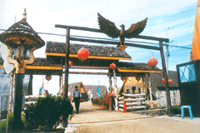
They are pouring money into new facilities. They are purchasing huge advertisements to hawk their selling points. They are offering deep cuts on travel fares. But more than anything else, they are desperately seeking a theme.
For the Chinese tourism sector, business in 2005 seems to be a war for a theme, or any significant message that tourism officials or managers anywhere can find to lure tourists to their cities' attractions.
Besides traditional promotions about "beautiful scenery" and "warm and hospitable people" in Chinese guidebooks published not long ago, there are a variety of themes fervently being developed.
A "sunshine tour" features health and fitness, such as swimming on Hainan Island.
A "folk culture tour" caters to those seeking knowledge about the nation's diverse local cultures and traditions.
A new "red tour" focuses on cities and sites that were important during the Chinese revolution.
The "DIY tour" - do it yourself tour - finds groups and individuals driving their own vehicles to places not usually visited by group tours.
And the "overseas tour" leads many Chinese to explore exotic views and cultures for the first time in their lives, extending travel to more routes and more destinations.
China is rich in travel resources and travel agencies obviously see a huge market to advance. The industry has been greatly enhanced since the country's Golden Weeks were introduced in 1999 to heighten domestic travel consumption.
Three times a year during Spring Festival, Labor Day and the National Day holidays, people pack up and head to places they normally have no time to visit.
Traditional travel destinations like Beijing and Xi'an host scores of millions of visitors every year. Natural scenic spots like Huangshan Mountain and Zhangjiajie Mountain continue to attract travelers nationwide. Small ancient towns like Pingyao, Zhouzhuang and Lijiang also lure visitors with their unique charms.
As people come to understand the huge economic benefits behind the World Heritage title, a trend craving fame for areas has swept all over the country in the past few years. Promotion and management have been enhanced. Transportation and accommodations have been improved. Along with huge incomes to locales, however, development of tourism resources also can bring damage to local environments.
Elevators are built on cliffs and guesthouses have been erected in forests. Consumer waste is randomly discharged, causing great damage to the Mother Nature. At the same time, related protection work can hardly keep up with increased guest flows. In some historical sites and scenic spots, fake relics and manmade scenes actually turn visitors away.
While traditional tourist destinations continue to retain their market shares, other regions are developing their unique characteristics to compete for their share of the pie.
Hainan Province, which is based on China's second largest island in the South China Sea and boasts the country's finest weather and best beaches, has developed its own theme of "Sunshine " and "Health Tourism."
Sitting in the southernmost boundary of the country, with most of its realm in a tropical zone, Hainan Province has a comfortable climate all year round. Sunshine, beaches and advanced medical treatment levels are attractions for people who want to escape from the severity of winter, to shy away from the pressures of heavy work or to cure their illnesses in the shining paradise.
Another theme of "Red Tourism" has been developed to promote visits to historic communist sites nationwide that served as bases for modern Chinese revolution.
The National Tourism Administration even declared 2005 the "Year of Red Tourism" and issued a list of "30 choice red tourism routes" and "100 classic red tourism sites." They include cultural saints like Xibaipo, a village in the remote Taihang Mountains where early Chinese leaders charted the blueprint for the founding of New China.
These tours aim to guide the public to remember great historical figures and their contributions to the birth of the People's Republic.
Also, it will help the economically backward former revolutionary bases catch up in development.
Many sites associated with China's revolution are in poor, rural areas that have been left behind as eastern cities surge ahead in a two-decade-old economic boom. Now, "Red Tourism" offers a good chance for a breakthrough.
It is expected that the tours will raise 100 billion yuan (US$12.1 billion) by 2010 for these sites. Increased tourism could bring job opportunities for 2 million people and indirectly affect 10 million.
For another group of people, China's expanding middle class, overseas destinations are another choice when they think about traveling.
Since Thailand opened to Chinese travelers in 1989, 63 countries and regions had become approved destinations by the end of last year.
One of the world's fastest-growing tourism markets, China already has opened up to foreign marketers as part of its commitments as a World Trade Organization member. Now there are five foreign-owned travel services and 13 joint-venture travel services here.
Last year, Chinese made 28.5 million visits abroad, up 40 percent over 2003. And several industry analysts expect this number to increase significantly as more and more foreign countries become approved tourist destinations and the Chinese people gradually enjoy greater disposable incomes.
It is estimated by the World Tourist Organization that the figure could reach 100 million by 2020.
(China Daily April 2, 2005)
|

